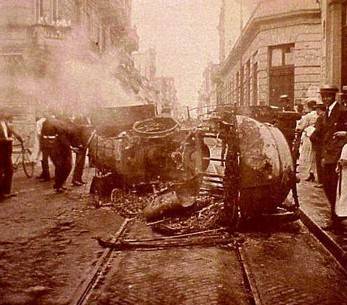This Day in Labor History: January 7, 1919

On January 7, 1919, the maritime workers in Buenos Aires voted to go on the strike. The culmination of years of radicalism, the state forces of Argentina responded by intense violence against the city’s working class over the next week. The Semana Tragica became one of the defining events of Argentine history.
Argentina had quite a history of working class radicalism, particularly anarchism, by early 1919. The German and Russian anarchists who fled their homes to avoid political repression (and given the popularity of anarchism in sections of the Jewish population, particularly in the Bund, anti-Semitism that was melded into that) often came to the United States. Most of the anarchists wrongly convicted for the Haymarket bombing in Chicago in 1886 were Germans, but the guy who almost certainly did throw it (or the most likely person anyway since we will probably never really know) was another German anarchist who subsequently fled to Argentina. As the nineteenth century went on, Argentina became a more frequent home for European anarchists, including from that center of anarchism over there, Italy.
In fact, Argentina had a long history of anarchist bombings by 1919. Beginning in 1902, under the leadership of the Italian anarchist Pietro Gori, the Federación Obrera Regional Argentina (FORI), the major Argentine labor federation, had engaged in increasingly militant labor actions that by the late 1900s, tended toward bombings. An anarchist bomb nearly killed the president of Argentina in 1908. On May Day 1909, the cops busted up an anarchist rally, killing 12 workers. The cops then blamed the anarchists for starting the violence, which was almost certainly a lie. Later that year, a Ukrainian anarchist responded by throwing a bomb into a car with Buenos Aires’ police chief, killing him. That led to the rise of far-right anti-worker militias, usually made up of college students.
Meanwhile, the Argentine state was extremely anti-labor and attempted to pass anti-labor legislation and use the police and military to bust strikes across this period. But that changed in 1916, when a pro-labor government was elected and at least tried to make deals with the anarchists.
So by 1919, there was a long history and deep hatred between the cops and the working class of Buenos Aires. A strike began at an English-owned metal factory just outside of the city. It didn’t seem like any huge deal at the moment, just another strike at a firm that wasn’t really that large anyway. But on January 3, the strikers opened fire on three cops escorting scabs bringing metal into the mill. All three were hit and one died the next day. It was a serious escalation. Four days later, on January 7, the city’s sizable dock workers voted for a general strike to increase their wages. That same day, the workers at the metal factory opened fire on the cops again and killed a military officer escorting them, as well as one of the right-wing college students engaged in the scab militia attacking the workers.
That night, things escalated throughout the city. Workers began to ambush cops and army forces in the city. A few more army officers were killed. The next day, the general strike took off. Then on January 9, a huge funeral march took place to honor five workers killed by the cops in these actions. That night, FORA issued the call for a general strike throughout the city. The besieged cops called on citizens to join them in defending order, This unloosed the right-wing college student militias.
The next several days consisted of uncontrolled violence. Because so many of the anarchist workers were Jews, the college students started attacking the city’s Jewish community and basically engaged in Russian-style pogroms. Right-wing newspapers openly called for anti-Jewish pogroms as well. It worked. Maybe 100 or more Jews were killed in Buenos Aires in these days, with right-wingers searching homes, dragging Jews out, beating them, and sometimes killing them. Anti-labor violence and anti-Semitic violence could go very well together, particularly when hard-right economic elites find it in their interest to do so and we know how moderate liberal types respond when the left commits actual violence against forces of order, which is mostly to be concerned about the violence and not the reason behind it.
We will never know just how many people were killed in the Semana Tragica. A leftist newspaper at the time said it was about 700. Scholars have claimed it was more like 100. On the other hand, the U.S. embassy at the time suggested it was about 1,500 dead, mostly Jews murdered by the pogroms, plus it reported widespread rapes of Jewish women. Who knows. Of course right-wing newspapers downplayed all of this. In any case, it all ended after the government declared martial law on January 12. The anarchists did attempt assaults on the military bases, mostly to steal guns and ammo, but they were repelled and by January 14, the fighting was over.
The Semana Tragica did not exactly disappear from the Argentine imagination, nor did it eliminate the anarchist presence. In the late 1920s, there was a spate of anarchist bombings in revenge for what had happened a decade earlier, leading to another round of repression. In some ways, it wasn’t until the rise of Juan Perón managed to co-opt the workers movement as part of his vision of the state that that sheer fury of the workers movement was at all abated.
This is the 507th post in this series. Previous posts are archived here.
